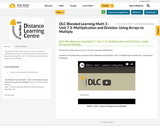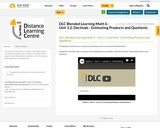
Some great ideas in here!
- Subject:
- Education
- Material Type:
- Teaching/Learning Strategy
- Author:
- PBS
- Date Added:
- 02/12/2019

Some great ideas in here!

How do you know if a chemical equation is balanced? What can you change to balance an equation? Play a game to test your ideas!

How do you know if a chemical equation is balanced? What can you change to balance an equation? Play a game to test your ideas!

The purpose of this lesson is to use an array to represent multiplication.
Included is a YouTube video to support Grade 3 Blended Learning Math - Unit 7.3: Multiplication and Division - Using Arrays to Multiply.

The purpose of this lesson is to explore estimating products and quotients with decimals.
Included is a YouTube video to support Grade 6 Blended Learning Math - Unit 3.2: Decimals - Estimating Products and Quotients.

Students will be able to identify healthy dairy products, describe the dairy process, and strengthen writing and sequencing skills.

The students will learn about livestock raised in Iowa while strengthening their language arts and 21st century skills through basic internet research.

This is a variety of ideas for ways students can share their learning.

Create your own sandwich and then see how many sandwiches you can make with different amounts of ingredients. Do the same with chemical reactions. See how many products you can make with different amounts of reactants. Play a game to test your understanding of reactants, products and leftovers. Can you get a perfect score on each level?

Students investigate the endothermic reaction involving citric acid, sodium bicarbonate and water to produce carbon dioxide, water and sodium citrate. In the presence of water [H2O], citric acid [C6H8O7] and sodium bicarbonate [NaHCO3] (also known as baking soda) react to form sodium citrate [Na3C6H5O7], water [H2O], and carbon dioxide [CO2]. Students test a stoichiometric version of the reaction followed by testing various perturbations on the stoichiometric version in which each reactant (citric acid, sodium bicarbonate, and water) is strategically doubled or halved to create a matrix of the effect on the reaction. By analyzing the test matrix data, they determine the optimum quantities to use in their own production companies to minimize material cost and maximize CO2 production. They use their test data to "scale-up" the system from a quart-sized ziplock bag to a reaction tank equal to the volume of their classroom. They collect data on reaction temperature and CO2 production.